| 3.0 Introduction |
3.3.1 Lexical Analyzer Generator Step 1:
Converting a Regular Expression to a Finite
Automaton
There are six steps (a) - (f):
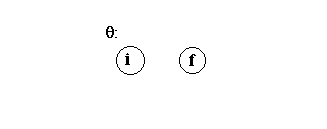
The diagram above shows that the regular expression ![]() is recognized by a nondeterministic finite automaton that has no
way to get to a final state.
is recognized by a nondeterministic finite automaton that has no
way to get to a final state.

The diagram above shows that the regular expression ![]() is recognized by the nondeterministic finite
automaton which goes from its initial state to its final state by reading no input. Such a
move is called an
is recognized by the nondeterministic finite
automaton which goes from its initial state to its final state by reading no input. Such a
move is called an ![]() - transition
- transition
In table form this would be denoted:

The reader may be wondering about an input of ![]() and how it would be recognized by the driver. In fact, it will not
be. This is just a first step in table creation, and we will allow the creation of a
nondeterministic finite automation (NFA). Section 3.3.2
outlines how to turn this NFA into a deterministic finite automation (DFA)
and how it would be recognized by the driver. In fact, it will not
be. This is just a first step in table creation, and we will allow the creation of a
nondeterministic finite automation (NFA). Section 3.3.2
outlines how to turn this NFA into a deterministic finite automation (DFA)

The diagram above shows that the language {a} denoted by the regular expression a is recognized by the finite automatation that goes from its initial to final state by reading an a. In table from this would be:

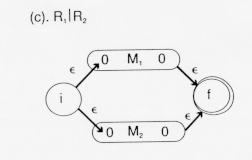
In the diagram above, we presume that the languages denoted by the
regular expressions R![]() and R
and R![]() , respectively, are recognized by the finite automata denoted by M
, respectively, are recognized by the finite automata denoted by M![]() and M
and M![]() .
.
Adding ![]() -transitions to the beginning and
end creates a finite automation which will recognize either the language represented by R
-transitions to the beginning and
end creates a finite automation which will recognize either the language represented by R![]() or the language represented by R
or the language represented by R![]() , i.e., the union of these two languages, LR
, i.e., the union of these two languages, LR![]() U LR
U LR![]() .
.
We could eliminate the new final state and the ![]() -transitions to it by letting the final states of M
-transitions to it by letting the final states of M![]() and M
and M![]() remain final states.
remain final states.
In table form, this is:
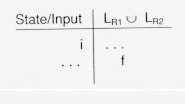
Here, the table entry for f is shown in a different row because the
process of recognizing strings in either LR![]() or
LR
or
LR![]() may lead to other intermediate states.
may lead to other intermediate states.
Our example, which recognizes
Letters = A | B | C | . . . | a | b | . . . |z
and Literal = 0 | 1 | 2 | . . . | 9
will use this step.

In the diagram above, M![]() is the
machine that accepts LR
is the
machine that accepts LR![]() and M
and M![]() is the language that accepts LR
is the language that accepts LR![]() . Thus, after this combined automation has recognized a legal string
in LR
. Thus, after this combined automation has recognized a legal string
in LR![]() , it will start looking for legal strings
LR
, it will start looking for legal strings
LR![]() . This is exactly the set of strings denoted
by R
. This is exactly the set of strings denoted
by R![]()
![]() R
R![]() . The related table is:
. The related table is:
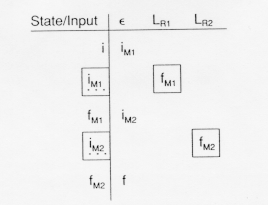
Here the table leads from an initial state, i, to the final state of M![]() upon recognition of strings in LR
upon recognition of strings in LR![]() , then from the final state in M
, then from the final state in M![]() , fM
, fM![]() to the initial state
in M
to the initial state
in M![]() on an
on an ![]() -transition, that is, without reading any input, and then from the initial
state in M
-transition, that is, without reading any input, and then from the initial
state in M![]() , iM
, iM![]() to the final state in M
to the final state in M![]() , fM
, fM![]() upon recognizing the strings in LR
upon recognizing the strings in LR![]() . The
. The ![]() is
often omitted. It is understood that two regular expressions appearing next to one another
represents the concatenation. We will use this step for the example, when we define an
identifier as a string of letters and digits (conatenated). Another example will recognize
a literal as the concatenation of one or more digits, that is,
is
often omitted. It is understood that two regular expressions appearing next to one another
represents the concatenation. We will use this step for the example, when we define an
identifier as a string of letters and digits (conatenated). Another example will recognize
a literal as the concatenation of one or more digits, that is,
Identifier = Letter (Letter | Digit) *
means
Identifier = Letter (letter | Digit) *

Here, M is a finite automation recognizing some LR. A new initial state is added
leading to both M and to a new final state. The ![]() - transition recognizes the empty string,
- transition recognizes the empty string, ![]() (if R did not contain
(if R did not contain ![]() already).
The transition to M causes the language LR to be recognized. The
already).
The transition to M causes the language LR to be recognized. The ![]() transition from all final states of R to its initial state will
allow the recognition of LR
transition from all final states of R to its initial state will
allow the recognition of LR![]() , i = 1, 2,... The
table is:
, i = 1, 2,... The
table is:
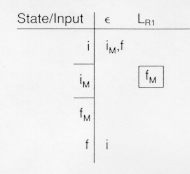
We will use this step as well as the preceding two, for the regular expressions
Identifier = Letter (Letter | Digit)*
and
Literal = Digit* = Digit Digit*
Using these diagrams as guidelines, we can "build" a nondeterministic finite automation from any regular expression (See Exercise 6
![]()